Mytek Audio has been high performance DACs as well as analog to digital converters in New York City since 1992, when Mytek was established by the founder and president Michal Jurewicz, working then at the Hit Factory and Skyline recording studios. For the first 18 years Mytek built mastering digital converters for recording studios, and has participated in major hi-res audio R&D projects, including a commission for a DSD master recorder for Sony Super Audio CD launch campaign. In 2010 Mytek entered the Audiophile market with the same mastering sound quality and had success with the versatile Brooklyn DAC, the first third party MQA capable DAC, followed by more DACs and streamers, several of them winning “product of the year” awards. Design and product ideas currently originate at Mytek Brooklyn Headquarters, while the manufacturing is handled by Mytek Europe in Warsaw, Poland. I am most familiar with the company as a builder of digital products like DACs and streamers, while their amplifiers designs started later in 2017 with their first Class D Brooklyn Amp. Currently Mytek makes three product lines, which now consist of streamers and new-school audiophile amplifiers.
The latest amplifier from Mytek is the Empire Stereo GanFET. The Empire tier of products represents the reference Mytek has to offer. It includes a streamer/DAC, as well as the stereo amplifier. The Empire stereo amplifier uses the latest Gallium Nitride field effect transistors (GaN-FET), which are all the buzz in the audiophile world. One major improvement over the Mos-FET transistors typically used in Class-D amplifiers is their speed. I’m not going to try to educate you on everything GaN-FET; however, I will refer you to an excellent article written by our editor, Jerry Del Colliano, who explains GaN technology in great detail. One of the major advantages of these transistors is that they switch as much as 30 times faster than Mos-FETs. The end result is that this allows them to more closely recreate the source signal, as a traditional Class-A amplifier does. They also promise high efficiency, low/no heat, ultra-low noise, and sonic performance on par with the best Class-A amplifiers. What’s not to love about that? This explains why there has been an explosion of GaN-based amplifiers making an uber-competitive landscape for manufacturers. How does the Mytek Empire stereo stack up? Let’s find out.
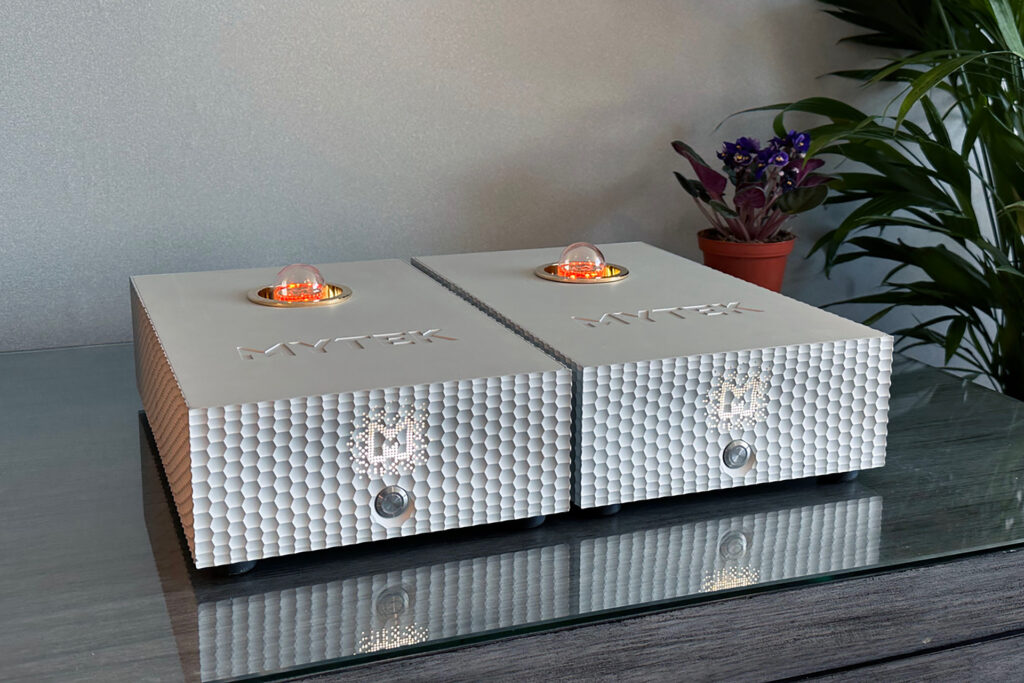
What Makes the Mytek Empire Stereo Amplifier So Special?
- The Mytek Empire stereo amplifier was tuned to deliver the benefits of Class-A amplification. Class-A amplifiers have transistors, which are always on and do not suffer from crossover distortion the way an AB amplifier does. Crossover distortion is when a pair of transistors operate together, each amplifying half of the waveform. When the signal transitions from one transistor to the other, there is always some sort of mismatch, which effects the output signal. Class-A is known for smoothness and lack of grain, along with outstanding transparency and warmth.
- The Mytek Empire stereo amplifier uses a proprietary GaN-FET power module. There are many competing designs using these transistors in their amplifier modules, but most use off-the-shelf modules. Most traditional Class D MosFET designs typically use off-the-shelf modules.Mytek is unique, as it was designed in-house. Therefore, it should sound like no other competitor.
- The Mytek Empire Stereo Amplifier is upgradeable. The aforementioned power module is replaceable via plug and play socket, the idea being that when Mytek designs a better power module, owners will be able to replace their current one with the new one.
- The Mytek Empire stereo amplifier is bridgeable. The idea behind the Empire amplifier was to design a half-width chassis, so they could be used in a dual mono configuration, taking up the space of a standard chassis. In stereo mode, they produce 200 watts per channel. Bridged, they produce 400 watts at eight ohms and 700 watts at four ohms.
- The Mytek Empire stereo amplifier uses a large 800-watt linear power supply. This differs from most competing GaN-FET amplifiers that use switching power supplies, the idea being that a large linear power supply will be more capable at delivering power for transients.
- The Mytek Empire stereo amplifier uses an enclosure machined from a solid block of aluminum. While many lower-cost competitors use enclosures made from multiple pieces bolted together, the Mytek Empire is a single solid chassis. It is machined with a very attractive fish scale-like pattern, which is unique and interesting.
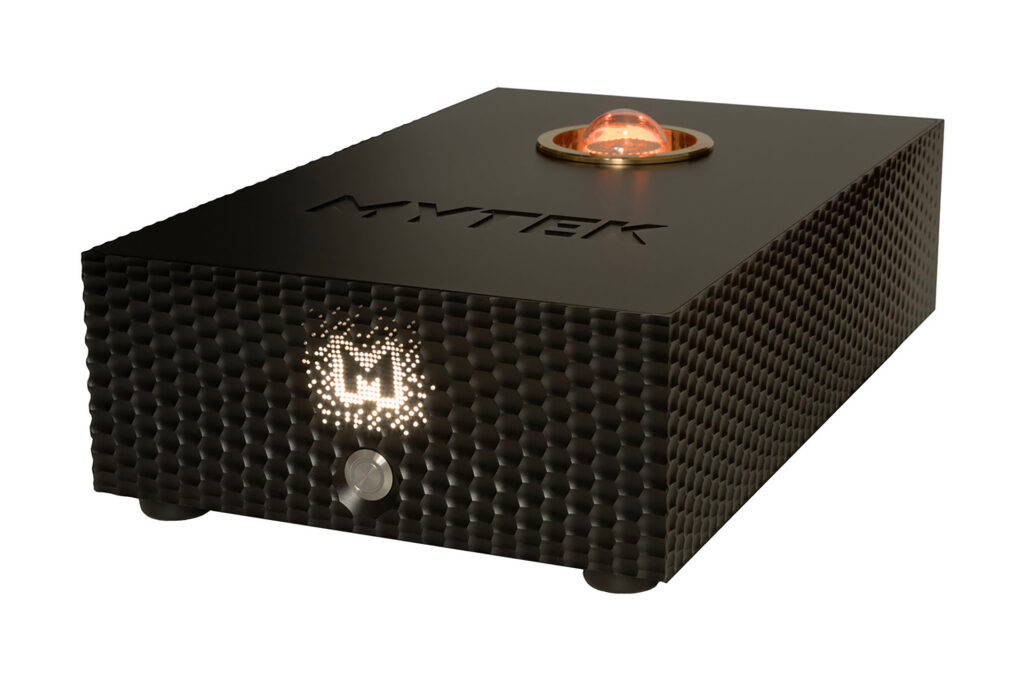
Why Should You Care About the Mytek Empire Stereo Amplifier?
The Mytek Empire GaN stereo amplifier represents the current ultra-high end of the Gallium Nitride class of amplifiers. It costs almost twice as much as the most expensive GaN amplifier that has been reviewed by the Future Audiophile team. It is not a me-too product, in that it uses a large linear power toroidal transformer like traditional high-power amplifier. The amplifier module is not an off-the-shelf Hypex or Pascal design, but an in-house design by Mytek. While this doesn’t necessarily mean that it sounds better than the competing amplifiers, it does bring additional cost.
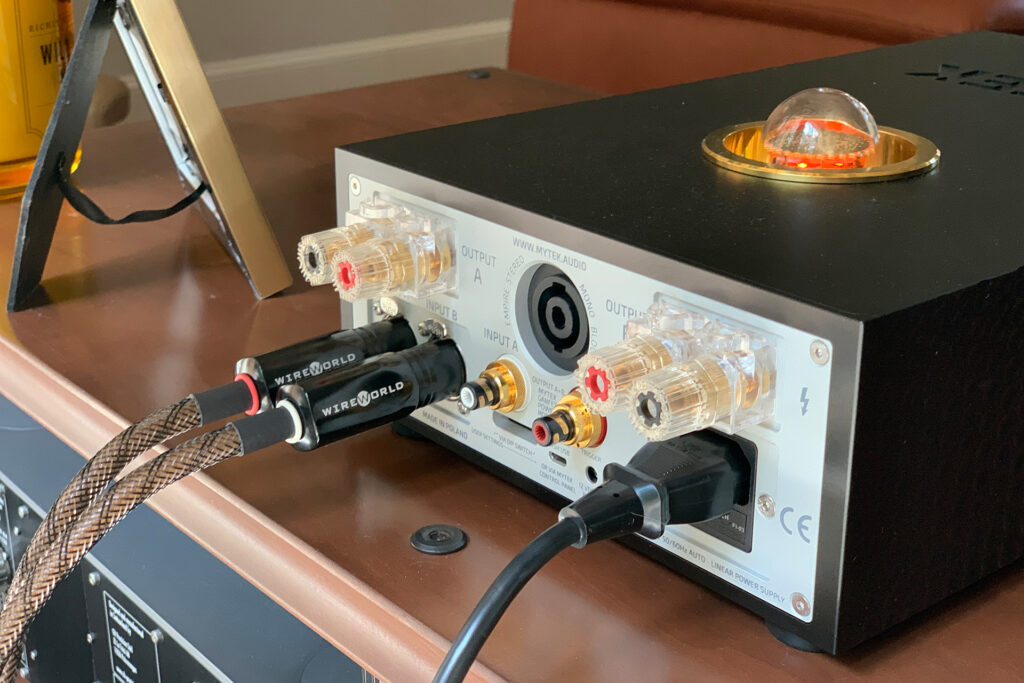
Some Things You Might Not Like About the Mytek Empire Stereo Amplifier
- The binding posts were a huge problem for me. I was really frustrated by them in the physical sense. Let me clarify: my frustration is with the configuration of the posts not necessarily the posts themselves. The Mytek Empire amplifier uses speaker terminals that only allow spade connectors to load from the top. There is no access to the sides or bottom of the terminals, as they are intentionally sealed off. This is necessary because the XLR and power cable connectors are directly below the terminals. I use Wireworld 10 Series speaker cables, which have short chunky leads and angled spade ends. It was impossible for me to use my cables without twisting them in a way that put them under considerable strain. The terminals also would have been in contact with the amplifier’s case, due to the angles of the spades. My workaround was to use spade-to-banana adapters. There is an option to use a Pro Neutrik Speakon connector in the middle of the rear panel. However, I would think most users have spade connectors and will be cursing the design, as I was.
- The Mytek Empire Stereo Amplifier styling is a mixed bag. The metal casework is well done and has an interesting fish scale-like texture on the sides, which was unique. However, it also has a fake vacuum tube on the top, which is meant to highlight the tube-like qualities the amp promises. It comes off as just silly and a bit gimmicky. Luckily, Mytek makes a replacement cover with the same fish scale texture as the sides to eliminate the tube. My review sample did not have this cover, so it served as a nightlight in my living room.
- I am not a fan of the current trend of half-sized chassis, which are especially popular with amplifier manufacturers, Mytek included. While I understand the idea is to use two of the Empire amplifiers in mono mode, which will occupy the space of a full-sized amplifier, I still don’t like it. The Mytek would absolutely benefit from a standard-width chassis, allowing for more room for rear panel connections. See my speaker cable terminal rant above.
- The Mytek Empire stereo amplifier did not include a physical owner’s manual (only a PDF), which is a major pet peeve of mine. I understand the world we live in, where environmental consciousness has become a religion for many, but I think we can live with using a few sheets of paper explaining how to use this amplifier. I am the guy who absolutely refuses to scan a QR code at a restaurant to look at the menu. I will find another establishment to spend my money at, regardless of how trendy it may be. Come on, manufacturers, include a user’s manual for old crusty folks like myself.
- The Mytek Empire stereo amplifier has various settings that the user may want to access, but they are difficult to change due to the use of dip switches on the rear of the unit. Settings such as brightness of the front display or top faux tube, operating mode (bridge, bi-amp, or stereo), gain (+23 or +29 dB) are all set from a series of recessed dip switches on the rear panel. Recessing them is a smart way to prevent dip switches from accidentally being changed and possibly damaging your speakers, but it also requires that you see clearly into the recessed slot. The only way that I could do this was by turning the amplifier around. This means it will need to be disconnected from your speakers and audio cables. It would be nice to have an easier way to make adjustments.
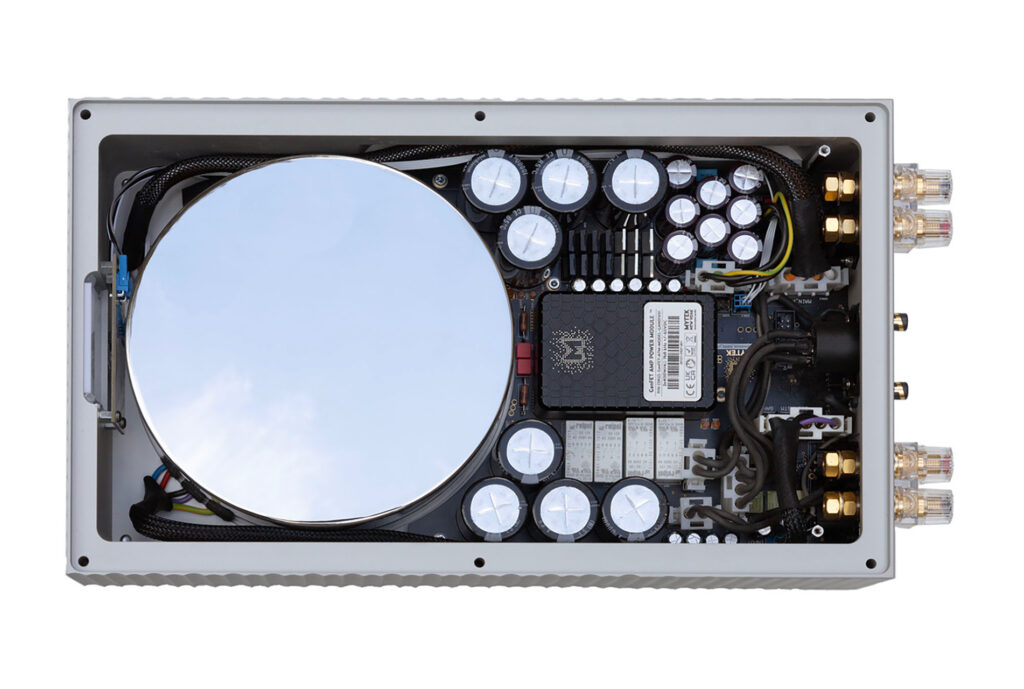
Listening to the Mytek Empire Stereo Amplifier …
My current reference system consists of a Lumin U1 mini-streamer, Weiss Helios DAC, CH Precision L1/X1 Preamp, CH Precision M1.1 Amplifier and Rockport Avior II loudspeakers. The Mytek Empire stereo amplifier was connected to the preamplifier using Wireworld series 10 Platinum Eclipse XLR cables.
I’ve been in a bluesy sort of mood as of late, so ZZ Top’s “Blue Jean Blues” seemed like a natural place to start in understanding the Mytek Empire stereo amplifier’s sound. As one would expect a blues track to be, it’s stripped down, slow and emotional. Billy Gibbons’ guitar was smooth and had a warmth that was just right. The reverb was clearly audible, indicative of a very low noise amplifier that doesn’t interfere with those subtle details that bring music to life. The midrange of this amplifier is the star, in my opinion. It has a sweetness that is highly listenable, but not overdone. Vocals shared the same warmth that I heard in the guitar. It still had all the grit that is unmistakable Gibbons, but perhaps a bit smoother than I’m accustomed to. Frank Beard’s kick drums were quick and taut. They didn’t seem to dig quite as deep as on my A/B amplifier reference, but they were still excellent. Take this with a grain of salt, as remembering what different configurations sound like is not an easy ask. Regardless, would the average listener be disappointed with the bass? Not a chance, it’s really good.
As I write this review, the world just sadly learned that Ozzy Osbourne has passed away. For Gen X metal heads such as myself, it’s a surreal feeling, as so much of my youth was backed by his music, so it felt only right to include some of his work. “Black Sabbath” by Black Sabbath tells a deep dark story of a man learning he has been condemned to Hell. The track opens with the effects of rain, thunder and church bells, creating one of the eeriest soundscapes you’re likely to hear. Now add the crushingly heavy Tony Iommi riff, which may very well be the origin of the heavy metal genre. Osbourne’s unmistakable voice against that backdrop full of tension and palpable fear creates a terrifying experience. It’s a five-minute sonic horror film, which sticks deep in your memories.
The drums of Bill Ward create a massive depth of soundstage, sounding as if they were being played at the end of a long tunnel. Osbourne’s vocals are front and center, with subtle but clear reverberations of each word, which adds to the cave-like atmosphere of the recording. Around four-and-a-half minutes into the track, the tempo speeds up, mimicking a racing pulse. The rhythm section of Ward and Geezer Butler is strong and heavy, driving the song forward. It was easy to separate the bass from the kick drum, showcasing the clarity and lack of noise from the amplifier. I heard a slight sweetness in the midrange on Osbourne’s vocals, just as I heard with the previous track. The upper mid-bass, along with the excellent midrange, were standouts.
Will the Mytek Stereo Amplifier Hold Its Value?
Mytek is a relatively new audiophile company that doesn’t have the name recognition of the blue-chip manufacturers like McIntosh or perhaps Audio Research. However, Mytek has a positive reputation, based on my research of owners online. The GaN-FET amplifier market is brand-new and there is a lot of competition, many of which are more affordable than the Mytek Enterprise amplifier. The Mytek Enterprise amplifier does differentiate itself from the competition with a machined billet chassis, large linear power supply and a proprietary amplifier module. It’s tough to say how it will do on the used market, since it’s a new product with rapidly changing technology. On a positive note, the fact that the amplifier module can be replaced when a better version is designed makes it much easier to invest in.
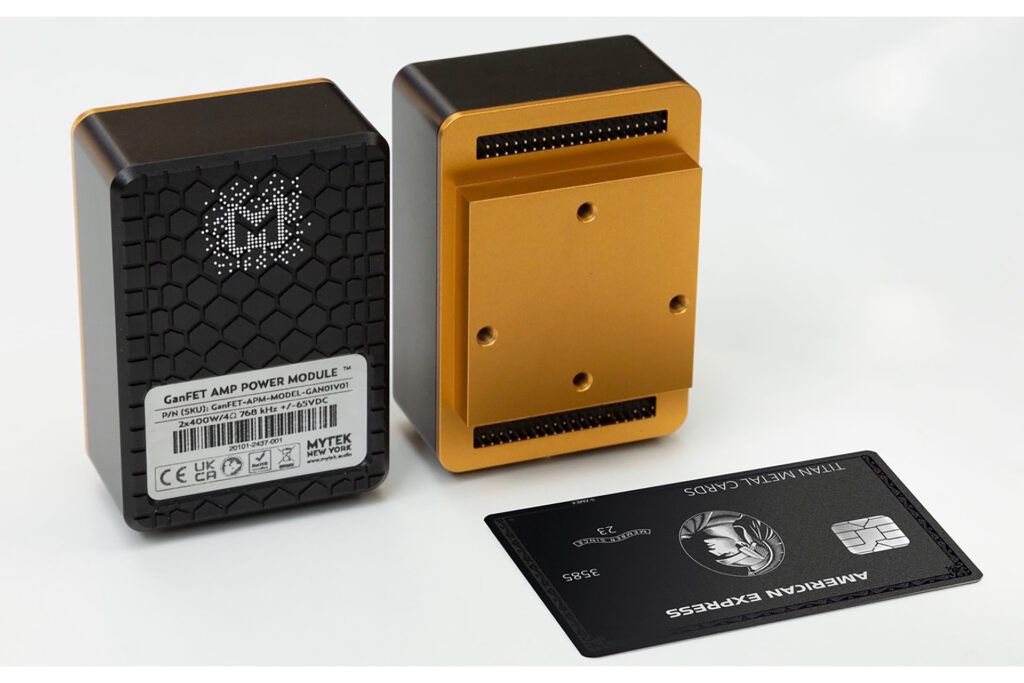
What is the Competition for the Mytek Empire Stereo Amplifier?
The first competitor that comes to mind is the Atma-Sphere Class-D GaN Mono Amplifier. The Atma-Sphere amp is true mono, so you will need a pair of them right out of the gate. However a pair is still almost $3,000 less expensive than the Mytek Empire stereo GaN amplifier. Keep in mind the Atma-Sphere Mono amps only produce 100 watts at eight ohms, compared to 200 watts for the Mytek in stereo mode.
Next, I would consider the Argent Pur GaN-FET Amplifier (mono – read the review), which like the Atma-Sphere is also true mono and similarly priced at $5,900 for a pair. The Argent Pur amplifiers use silver wiring internally and produce 250 watts at eight ohms. Like the Mytek Empire stereo amplifier, they have invested in casework an audiophile appreciates and expects.
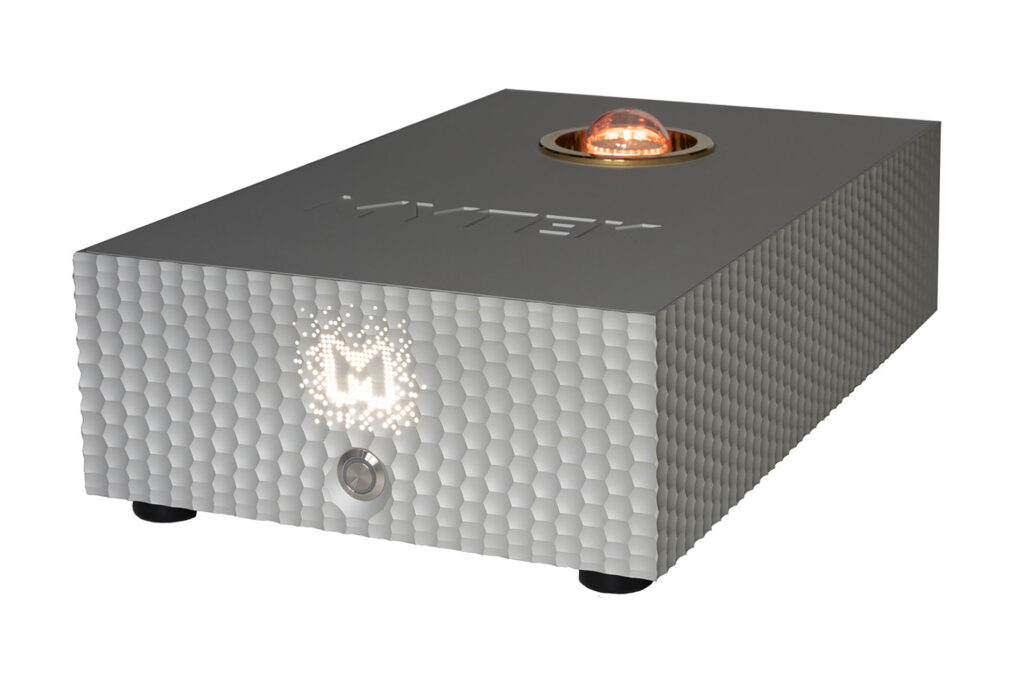
Final Thoughts on the Mytek Empire Stereo Amplifier …
The Mytek Empire stereo amplifier occupies an interesting position in the GaN-FET amplifier market. While most GaN-FET amplifiers seem to be racing to the bottom in terms of price, Mytek has decided to take their GaN-FET amplifier decidedly upmarket. How will the nearly-$10,000 stereo amplifier fare against competitors costing half as much? Time will tell. Some people will simply discount the Mytek Empire stereo amplifier based on price alone. These are the same people who will argue that cables don’t make a difference, all DACs sound alike because all ones and zeros were created equal, etc. I’m sure many will read this review and probably call me an idiot or much worse. That’s okay. This amplifier is clearly not intended for that crowd.
The Mytek Empire stereo amplifier is intended for someone who wants a Class-A amplifier but can’t justify an amplifier that requires a forklift to move, or a personal nuclear reactor to power it. They don’t want the heat that traditional Class-A amplifiers generate, but also don’t want to sacrifice sound quality. They appreciate things like nice casework, a billet chassis and a massive toroidal transformer.
None of these features matter, however, if the amplifier doesn’t deliver on its Class-A promises. To my ears, the Mytek does that. The midrange and mid-bass are really, really good. Vocals have a sweetness and sense of realism that makes music come to life. The top end is clear and detailed, without a hint of harshness. The Empire stereo amplifier is ultra-quiet, which makes images jump from an inky black background. Imaging is excellent, as is the soundstage size. This is a highly listenable amplifier that I really enjoyed after I stopped screaming about the binding posts. If you are considering a GaN-FET amplifier, you should absolutely audition the Mytek Empire Stereo amplifier. You have nothing to lose, as Mytek offers a generous 30-day audition period.




Nice review. I’d like to hear this amp from your description of sound.
I laughed to myself when you were talking about turning the amp so you can adjust the DIP switches. I don’t see so I just reach over the top to connect/disconnect. I just remember the layout. Of course something new like you had I’d need someone to tell me where things are or get an idea from the manual.
Typically I do that too Bryan. The dip switches on the Mytek Empire are recessed behind 1/4″ of Aluminum so it would be difficult to do without being able to see them. I am sure however you’d find a way to make it work!
Thanks for the kind words.
It may be helpful to add that the ArgentPur dual-mono DUO STEREO DUO amp that matches this Mytek stereo is only $5300 (vs $5900/pr Monoblocs), while offering true dual power supplies (1.6kW total).
I’ve always read GanFet amp reviews that only compare them to “standard, run of the mill” silicon based Class D amps; and their virtues are described thusly.
But NEVER do I read any comparing them to topshelf Class D modules that implement high end Eigentakt or Nilai amp modules which run typically half the price with better specs. Why is that?
Hi Eric and All,
We did compare and that’s why we went with GanFET
Here is the story:
Mytek has developed our own GanFET Class D modules you see above in the pictures in the last 4 years for use in our products and for the future OEM business.
When we started during Covid , it was me and another brilliant engineer locked down with my family in upstate New York with all the time to experiment for many long evenings.
Our aim was to built the best monoblock power amps possible to match our $25k new Empire DAC Streamer sound quality, AND, most importantly to be as good or better than the best Class A/B amps.
We did have experience with Class D modules from Pascal as we already made Brooklyn AMP few years earlier using these modules we actually hotroded by using faster transistors and faster clock etc and got them to sound better yet.
When we do this type of R&D we have a listening room with good speakers, A/B/C/D/E instant/blind switch with several amplifiers we use as reference that we want to compare to/beat and our test circuits, and various specialized measurement gear including Audio Precision.
And then we listen, draw conclusions, measure, change circuit, measure and listen again and so we go for months until we are satisfied with results.
Listening satisfaction is always our main goal (unlike in Eigentakt where the measurements were the goal).
When we started we though that maybe a large 800W Pascal Module (btw used in one of Jeff Rowland amps) will do the trick, we had this in the line up, we also bought a pair of Eigentakt, we had a tube amp, and couple of v.good Class AB amps and later also a Class A Threshold amp.
No matter how much we wanted the old class D to work, neither Pascal nor Egeintakt just could not challenge the best Class AB.
They always lost with their hard top and small soundstage and sometimes just sounding plain weird. We hit the wall. But we wanted Class D because of the architecture of the circuit , so then decision was made to try the new GanFET designs.
We bought all GanFET EVAL boards we could get our hands on, most of them designed by Skip Taylor and that was a revelation!.
Suddenly a flat small and glassy soundstage became real and 10 times bigger, finesse and reality returned and we could now truly start competing with the Class A/B and even Class A amps.
The whole process took us eventually 3 years before we fine tuned the results.
There was a lot of issues we had to work out as this is a brand new technology, for example circuit protection where its very easy to blow up transistors as the protection has to be faster than them.
Technology-wise you are dealing here with 120+ volts and up to 30A being switched in few nsec, these are extremely difficult to design, you need to use microwave design techniques.
During the process we learned that depending on architecture of the circuit sound can be molded- for example it can sound neutral or warm , so different Gan amps out there do sound different, but they all are better than old Class D design.
Overall results are stunning: a modern sounding amplifier with deeply extended very well defined bass and airy tube like upper midrange and top you can listen to for hours without your ears being pierced or you getting tired.
You can’t get this sound from old class D, even from the Eingentakt which is that old Class D hotroded with massive amount negative feedback.
No matter “the papers” that feedback messes up the dynamic performance and changes the sound, while no feedback or gentle feedback of a GanFET sounds beautifully sweet reminiscent of what we all love about tubes.
The science of this is very simple: if Class D amp had a perfect square wave on the output (90 degrees everywhere) it’d have zero distortion.
But because MOSFET transistors are not fast enough they mess the waveform up and this is what you hear.
GanFET transistors are 20 times faster and because of this waveform is much more square, and suddenly all the magic comes back.
Eigentakt fixes the MosFET waveform with massive negative feedback. We do it by using faster GanFET transistors.
I believe GanFET method is the real solution instead of a bandaid.
It results in stunning sonic results and if you ask me, my prediction is that in another 10-20 years GanFET will become a dominant hifi amplifier technology.
It’s Class D which sound like Class A and has all advantages of tight transistor bass, silky tube top and 95% efficiency that other Class of amplifiers just can’t deliver.
Then there is more to it: It’s possible to convert PCM to PWM and this is the ultimate frontier and the reason we wanted Class D.
It’s just extremely difficult to ge this to sound real high end. But we have something already up the sleeve and it’s very exiting next step.
I made a video on the subject if someone wants to look at the graphs: https://www.youtube.com/watch?v=mjrSSC3ugzE
Happy listening, Michal at Mytek
I (mostly) retired before getting a chance to design an amp with GaN output stages. However, as an EE from the highend audio world, I know enough to say GaN is only a (powerful) component in a very intricate design problem. You can get better handling and higher speed with great tires, but they won’t turn a Chevy into a Porsche.
Switching faster will reduce loss and improve heat (not eliminate it), allowing for better efficiency. High speed switching could also allow the filter design to eat less into the phase margin – which has always been an issue with Class D. However, I’ve not yet seen a design promoting linear phase in the audio band. Spread spectrum switching could help cheat the emissions testing, but that’s super complicated in a modulator if you want to avoid jitter.
Besides filter design and timing control, there’s still dynamic feedback so the amp looks like a pure voltage source regardless of the dynamic speaker load.. And of course, as is mentioned in the review – rock solid power. This applies to both the power for the speaker and the tightly regulated power for internal chips.
It’s complicated stuff. Yet, each of these elements are critical for high end system performance. Getting it right can cost a lot of money. Getting it close enough to right requires talented engineering.
Thanks for the insightful EE perspective.